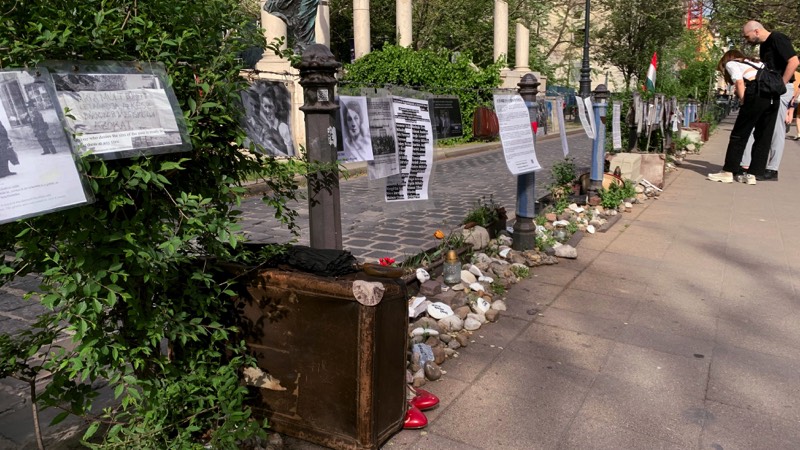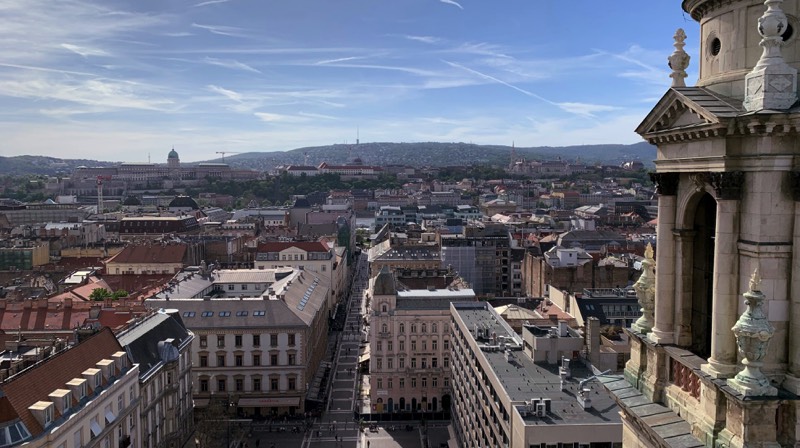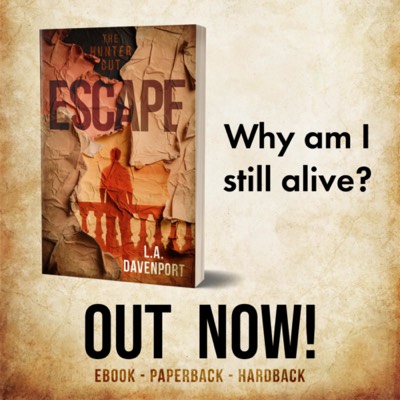The Dignity of Silent Protest
Opinion, 14 April 2024
by L.A. Davenport
This week, I was lucky enough to return to a city that I always enjoy visiting, and have seen undergo sweeping changes over the past two decades, while retaining its sense of self.
I am talking about the capital of Hungary: Budapest.
Yes despite its charms old and modern, and the unstinting friendliness of its people, it can be hard place to get to know.
I am sure this is quite deliberate, but it can feel difficult to break out of the ‘tourist zone’ and escape into more ‘real’ parts of the city. However, all it really takes is to walk that bit further, turn a few additional corners and head into the quieter, darker streets that lay beyond.
One evening, after a long day of seemingly endless work, I realised I was fed up with going past the same old restaurants and the same old bars in search of food and entertainment, so I deliberately headed straight through the party zone and out into the unknown.
It didn’t take long before the thudding beats and the glare of the bright lights fell away and the atmosphere became less jarring. The sense of being pulled this way and that by urgent signs and voices calling me over to their restaurant, bar or even strip club retreated.
The streets returned to a more human, intimate, local scale. They were no longer an obstacle course to be navigated, in which the objective was to get to the end without having your wallet lightened, but rather a journey into what seemed more like Budapest proper.
I soon came across Saint Teresa of Ávila Parish Church, which has a modestly imposing 18th century exterior but a peak through the deep-set doors instantly drew me into a rather glorious interior that in some ways impressed me more than that of St. Stephen's Basilica.
However, it was the celebration of mass that moved me the most. The congregation was small but their sincerity was all-too evident.
After watching the handful of people take their turn to receive communion, I was struck with the melancholic thought that perhaps this will be the last generation to prostate themselves before the altar, and the church will one day fall into disuse.
I do hope not. Whatever one may think about organised religion, I find a profound beauty, especially so close to Easter, in the idea of dedicating oneself to God and consciously living according the teachings of Christ.
After a Mexican meal that reminded me why I should not choose a restaurant when I am famished—a state that always blunts the objectiveness of my faculties—I headed for a rather charming and enticing coffee shop I had spotted on my pre-dinner wanderings.
In both decoration and ambience, Café Zsivágó is a cross between a café, a bar, a library and a home, and achieves that rare thing of making customers who not only have not only never been there before but also could never be locals feel instantly at home.
It was a balmy evening, and the tables crowding the entrance were buzzing with lively chatter and laughter that echoed around the alleyway, but I left them behind and headed further inside once I had ordered my alcohol-free beer.
I settled on the back room and I seated myself by a table adorned with a lamp that reminded me of my grandmother’s house, an entire generation ago.
As they say in Edwardian novels, I beguiled the evening hours alternating between reading a magazine I had brought from the unread pile by my bed and people-watching.
After a while of trying, but failing, to deduce the direction of the conversation at a nearby table, I realised I had finally found what I had been seeking in both my recent trips here: a sense of connectedness to the city and its people.
I am talking about the capital of Hungary: Budapest.
Yes despite its charms old and modern, and the unstinting friendliness of its people, it can be hard place to get to know.
I am sure this is quite deliberate, but it can feel difficult to break out of the ‘tourist zone’ and escape into more ‘real’ parts of the city. However, all it really takes is to walk that bit further, turn a few additional corners and head into the quieter, darker streets that lay beyond.
One evening, after a long day of seemingly endless work, I realised I was fed up with going past the same old restaurants and the same old bars in search of food and entertainment, so I deliberately headed straight through the party zone and out into the unknown.
It didn’t take long before the thudding beats and the glare of the bright lights fell away and the atmosphere became less jarring. The sense of being pulled this way and that by urgent signs and voices calling me over to their restaurant, bar or even strip club retreated.
The streets returned to a more human, intimate, local scale. They were no longer an obstacle course to be navigated, in which the objective was to get to the end without having your wallet lightened, but rather a journey into what seemed more like Budapest proper.
I soon came across Saint Teresa of Ávila Parish Church, which has a modestly imposing 18th century exterior but a peak through the deep-set doors instantly drew me into a rather glorious interior that in some ways impressed me more than that of St. Stephen's Basilica.
However, it was the celebration of mass that moved me the most. The congregation was small but their sincerity was all-too evident.
After watching the handful of people take their turn to receive communion, I was struck with the melancholic thought that perhaps this will be the last generation to prostate themselves before the altar, and the church will one day fall into disuse.
I do hope not. Whatever one may think about organised religion, I find a profound beauty, especially so close to Easter, in the idea of dedicating oneself to God and consciously living according the teachings of Christ.
After a Mexican meal that reminded me why I should not choose a restaurant when I am famished—a state that always blunts the objectiveness of my faculties—I headed for a rather charming and enticing coffee shop I had spotted on my pre-dinner wanderings.
In both decoration and ambience, Café Zsivágó is a cross between a café, a bar, a library and a home, and achieves that rare thing of making customers who not only have not only never been there before but also could never be locals feel instantly at home.
It was a balmy evening, and the tables crowding the entrance were buzzing with lively chatter and laughter that echoed around the alleyway, but I left them behind and headed further inside once I had ordered my alcohol-free beer.
I settled on the back room and I seated myself by a table adorned with a lamp that reminded me of my grandmother’s house, an entire generation ago.
As they say in Edwardian novels, I beguiled the evening hours alternating between reading a magazine I had brought from the unread pile by my bed and people-watching.
After a while of trying, but failing, to deduce the direction of the conversation at a nearby table, I realised I had finally found what I had been seeking in both my recent trips here: a sense of connectedness to the city and its people.

Memorial for Victims of the German Occupation, Budapest, Hungary.
The contrasts one finds in Budapest do not begin and end with the ‘tourist’ versus the ‘real’ city, of course. There are many others, of which one can be vaguely aware but initially unable to put one’s finger on.
On the surface, the city seems to be a place at ease with itself, relatively well-off, all things considered, and content. Yet anyone even vaguely familiar with the political situation in Hungary knows that cannot be the case for many people living and working in the country.
For a tourist wandering the centre of Budapest, there are few, if any, signs of the political currents that swirl around the city. I nevertheless became acutely aware of at least one in Liberty Square.
For a tourist wandering the centre of Budapest, there are few, if any, signs of the political currents that swirl around the city. I nevertheless became acutely aware of at least one in Liberty Square.
This was not the case for Hungary. The country collaborated with Nazi Germany as part of the Axis powers. It also took part in the invasions of Yugoslavia and the Soviet Union, and placed up to 40,000 primarily Jewish people into forced labour.
When Germany finally occupied Hungary in 1944, Hungarian authorities participated in the deportation of more than 400,00 Jewish people and approximately 600,000 in total, the vast majority of whom ended up Auschwitz-Birkenau. Over the same period, hundreds of thousands of other Hungarians lost their lives.
Yet why talk about this now, exactly 80 years later?
While taking in Liberty Square, I came across the Memorial for Victims of the German Occupation, a rather poorly designed monstrosity that was apparently erected under cover of darkness one Sunday morning in 2014. The intention was to commemorate the Nazi takeover of Hungary, and it shows the archangel Gabriel, representing Hungary, being attacked by a Germanic eagle with the year 1944 on its ankle, set against a backdrop of broken columns.
It was immediately controversial, as it was seen as an attempt to whitewash, or perhaps statue-wash, Hungary’s part in the Second World War, and understandably angered Jewish and other groups. At the time, Prime Minister Viktor Orbán was accused of “falsifying the Holocaust” and “confusing the murderer and the victim.” The Liberal Party called the construction “a memorial to the arrogance of the Hungarian government”.
When opposition politicians and two hundred civilian protesters tore down the protective fence around the memorial and pelted the statues with eggs on the Sunday morning, riot police stepped in.
I knew none of this when I initially found myself confronted by the memorial, but once I spotted the photographs, messages and objects, including suitcases and shoes, left in front it, the gravity and multiple meanings of the place sunk in.
Above all, I found the quiet dignity of the silent protest against the hubris of a government that thinks it can rewrite history, even if it doesn’t have the confidence to do so by daylight, extremely affecting. In some ways, I was surprised that they were left in place, which suggests that, for now, the power of Orbán’s regime is not absolute.
It also gives me hope that, one day, the many voices that make up modern Hungary will be heard, and the rights of all its citizen, no matter their religion or orientation, will be respected.
On the surface, the city seems to be a place at ease with itself, relatively well-off, all things considered, and content. Yet anyone even vaguely familiar with the political situation in Hungary knows that cannot be the case for many people living and working in the country.
For a tourist wandering the centre of Budapest, there are few, if any, signs of the political currents that swirl around the city. I nevertheless became acutely aware of at least one in Liberty Square.
For a tourist wandering the centre of Budapest, there are few, if any, signs of the political currents that swirl around the city. I nevertheless became acutely aware of at least one in Liberty Square.
This was not the case for Hungary. The country collaborated with Nazi Germany as part of the Axis powers. It also took part in the invasions of Yugoslavia and the Soviet Union, and placed up to 40,000 primarily Jewish people into forced labour.
When Germany finally occupied Hungary in 1944, Hungarian authorities participated in the deportation of more than 400,00 Jewish people and approximately 600,000 in total, the vast majority of whom ended up Auschwitz-Birkenau. Over the same period, hundreds of thousands of other Hungarians lost their lives.
Yet why talk about this now, exactly 80 years later?
While taking in Liberty Square, I came across the Memorial for Victims of the German Occupation, a rather poorly designed monstrosity that was apparently erected under cover of darkness one Sunday morning in 2014. The intention was to commemorate the Nazi takeover of Hungary, and it shows the archangel Gabriel, representing Hungary, being attacked by a Germanic eagle with the year 1944 on its ankle, set against a backdrop of broken columns.
It was immediately controversial, as it was seen as an attempt to whitewash, or perhaps statue-wash, Hungary’s part in the Second World War, and understandably angered Jewish and other groups. At the time, Prime Minister Viktor Orbán was accused of “falsifying the Holocaust” and “confusing the murderer and the victim.” The Liberal Party called the construction “a memorial to the arrogance of the Hungarian government”.
When opposition politicians and two hundred civilian protesters tore down the protective fence around the memorial and pelted the statues with eggs on the Sunday morning, riot police stepped in.
I knew none of this when I initially found myself confronted by the memorial, but once I spotted the photographs, messages and objects, including suitcases and shoes, left in front it, the gravity and multiple meanings of the place sunk in.
Above all, I found the quiet dignity of the silent protest against the hubris of a government that thinks it can rewrite history, even if it doesn’t have the confidence to do so by daylight, extremely affecting. In some ways, I was surprised that they were left in place, which suggests that, for now, the power of Orbán’s regime is not absolute.
It also gives me hope that, one day, the many voices that make up modern Hungary will be heard, and the rights of all its citizen, no matter their religion or orientation, will be respected.
© L.A. Davenport 2017-2024.
0 ratings
Cookies are used to improve your experience on this site and to better understand the audience. Find out more here.
The Dignity of Silent Protest | Pushing the Wave

